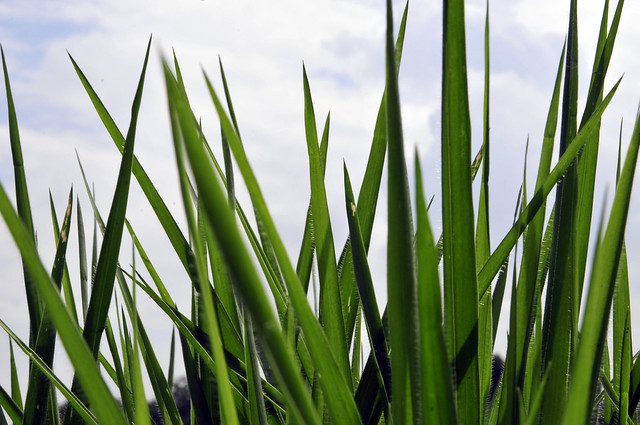Brachiaria trials at CIAT’s headquarters in Colombia. This improved forage grass has been shown to inhibit nitrification, helping to reduce the greenhouse gas emissions from agriculture (photo credit: CIAT/Neil Palmer).
‘Much has been written about why eating more red meat could be bad for your health while also harming the environment. But new studies to be discussed at the 22nd International Grasslands Congress in Australia next week show that the scientists might be able to overcome the environmental impact of higher numbers of meat eaters and milk drinkers.
‘Scientists have been predicting that a growing demand for meat and dairy products will lead to more deforestation, which will increase the harmful carbon dioxide released into the atmosphere as pastures are expanded and more land is devoted to sowing crops to feed the burgeoning population of animals reared for their meat and dairy products.
‘More animals will also mean rising emissions of warming gases such as methane directly from the livestock, and nitrous oxide from the fertilisers, manure and other animal waste. Both these gases are extremely harmful as their capacity to warm the atmosphere is far greater than carbon dioxide. . . .
‘Secrets in the grass
‘But evidence has been mounting that a chemical mechanism operating in the roots of a tropical grass used for livestock feed holds enormous promise for reducing the emission of nitrous oxide, which has a global warming potential 296 times that of carbon dioxide and is the most harmful of the warming gases.
‘The mechanism is known as “biological nitrification inhibition”, or BNI, said Michael Peters, who leads research on forages at the International Center for Tropical Agriculture (CIAT), based in Colombia. CIAT is a member of the Consultative Group on International Agricultural Research (CGIAR) Consortium.
‘Peters told IRIN the grass belongs to the Brachiaria species commonly found in east and central Africa and is native to the region. Animals that consume the grass produce higher yields of milk and their manure emits smaller amounts of nitrous oxide.
‘”A maize crop grown after planting a certain type of Brachiaria grass produces a respectable yield while using only half the usual amount of nitrogen fertilizer…” . . .
Other research has shown that deep-rooted, productive Brachiaria grasses can capture atmospheric carbon on a scale similar to that of tropical forests, and could be a further plus for climate change mitigation.
‘“Livestock production provides livelihoods for a billion people, but it also contributes about half of agriculture’s greenhouse gas emissions,” Peters explained. “BNI is a rare triple-win technology that’s good for rural livelihoods as well as the global environment and climate. . . .
‘Though Brachiaria grasses originated in Africa they are now planted more widely in South America. Peters told IRIN that breeding lines produced by CIAT have been brought back to Africa but currently cover no more than 10,000 hectares and involve only a few thousand farmers. . . .
‘Eminent scientists like P[hilip] Thornton from the International Livestock Research Institute have also been calling for regulations for better management of animal waste in the developing world, which could reduce the emission of nitrous oxide.’
Read the whole article at IRIN: Grass could tame global warming gases, 13 Sep 2013.
Notes
In their 2009 policy brief, ILRI’s Philip Thornton and colleague Mario Herrero argued that greenhouse gas ’emissions from livestock systems can be reduced significantly through technologies, policies, and the provision of adequate incentives for their implementation’. And they go on to advise, ‘Significant amounts of soil carbon could be stored in rangelands or in silvopastoral systems . . . . This would not only improve carbon sequestration but could also turn into an important diversification option for sustaining livelihoods of smallholders and pastoralists through collection of payments for ecosystem services.’
About the Brachiara research
Scientists at CIAT and the Japan International Research Center for Agricultural Sciences (JIRCAS) have researched BNI collaboratively for the last 15 years.
As a result of recent advances, scientists have developed means to exploit the BNI phenomenon on a large scale:
• CIAT researchers have found ways to increase BNI through plant breeding in different species of Brachiaria grasses. The new techniques include methods for rapidly quantifying BNI in Brachiaria together with molecular markers, which reduce the time needed for field testing.
• Center scientists have also just gathered evidence that a maize crop grown after Brachiaria humidicola pastures gave acceptable yields with only half the amount of nitrogen fertilizer normally used, because more nitrogen was retained in the soil, thus reducing nitrous oxide emissions and nitrate leaching. The researchers determined that BNI had boosted nitrogen-use efficiency by a factor of 3.8.
• In addition, scientists have developed hybrids of Brachiaria humidicola and delivered these, with support from the German government, to farmers in Colombia and Nicaragua for productivity and quality testing. Previous grass hybrids have increased milk and meat production by several orders of magnitude, compared to native savanna grasses, and by at least 30%, compared to commercial grass cultivars.
Originally from sub-Saharan Africa, Brachiaria grasses found their way to South America centuries ago—possibly as bedding on slave ships. Improved varieties of the grass are widely grown on pasturelands in Brazil, Colombia, and other countries, and they have recently been taken back to Africa to help ease severe shortages of livestock feed.
BNI research forms part of a larger initiative referred to as LivestockPlus, which proposes to deliver major benefits for the poor and the environment through innovative research on tropical forage grasses and legumes.
The LivestockPlus initiative takes place within the global framework of the CGIAR Research Program on Livestock and Fish, led by the Kenya-based International Livestock Research Institute (ILRI). The program aims to increase the availability and affordability of meat, milk, and fish for poor consumers and raise the incomes of smallholders producing these commodities.

